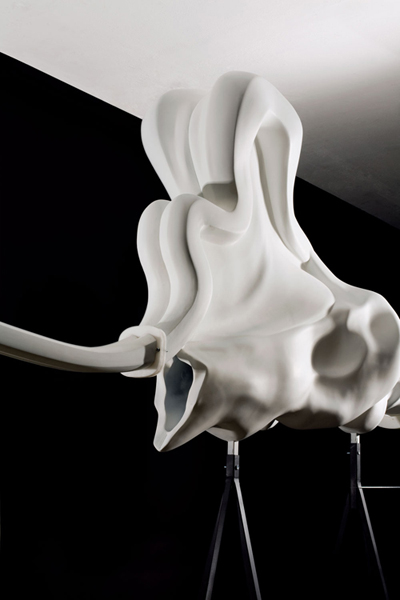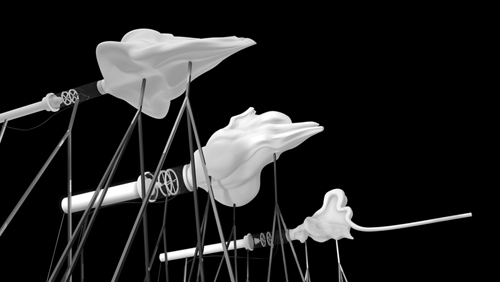Before you freeze to death in the Tyrolean mountains, consider this: 5000 years from now, if and when you are found, scientists will be able to tell the most personal details about you, even more than we know about Ötzi. Ötzi is the 5,300 year old man found in the Italian Alps in 1991, and he keeps yielding secrets. According to a recent article in the New York Times, Ötzi was 46. He died of an arrow shot, and had knee trouble. We know his hair and eye color, his blood type and the fact that he had parasites. We also know that he had tattoos, blackened lungs, doses or arsenic and copper in his system, and age-related skin degeneration. Now researches have learned that he was lactose intolerant, that his ticker was going to give out imminently, and that it was likely that he had Lyme's disease. We've got this guy figured out. But we'll never be able to hear Ötzi speaking -- the quality of his voice, his rhythms and vocalizations. Or will we?
Marguerite Humeau, a recent graduate of the Royal College of Art Department of Design Interactions, has unlocked the sound of an even older mammal: the Imperial Mammoth, a creature that became extinct around 6000 years before Ötzi froze. For her thesis project, titled "Back, Here Below, Formidable," Humeau reconstructed the sound apparatus of the mammoth, no easy task since the soft tissue of the throat doesn't fossilize. Humeau worked with scores of specialists including paleontologists, ear, nose and throat experts, laryngologists, RCA advisor James Auger and the explorer Bernard Buigues, who is credited with three major mammoth discoveries. She examined CT scans of modern relatives, like Asian elephants, and managed to manufacture an amazing reconstruction of the soft tissue of the mammoth including resonance cavities, a larynx with vibrating vocal cords, a windpipe, an air compressor, a programmed breathing system, and a subwoofer.
I heard this unforgettable work at the 2011 RCA graduate exhibition. The gallery was filled with an unfamiliar primal sound -- a deep guttural vibration that made it difficult to concentrate on other work. Humeau recently included three such extinct sound apparatus in an installation called "Proposal for resuscitating prehistoric creatures" in Politique Fiction at the Cité du Design in Saint-Étienne, France. Among them were the mammoth, an Entelodont or "Hell Pig" (circa 25 million years); and an Ambulocetus or "Walking Whale" (circa 50 million years). Here's a picture of her mammoth, the recent installation, the sound of the installation, and a video of Humeau discussing her work (listen to a full 33 seconds to hear the entire mammoth sound):
Mammoth Imperator:
 Image credits: Felipe Ribon
Image credits: Felipe Ribon
 Image credits: Stuart Bailes
Image credits: Stuart Bailes
Proposal for Resuscitating Prehistoric Creatures, Installation view (3D), Mammoth, Hell Pig and Walking Whale:
 Image credits: Ben Penna
Image credits: Ben Penna
Proposal for Resuscitating Prehistoric Creatures with good audio*:
Proposal for Resuscitating Prehistoric Creatures -- Installation Trailer from Marguerite Humeau on Vimeo
Now fast forward to the 21st century, where physicist Carl Haber and a team of scientists at the Lawrence Berkeley National Laboratory have been unlocking a variety of very early recordings from the 19th century, including the recently released sound capture of Thomas Edison's speech mechanism of a talking doll --the first known recording of a woman's voice. The Berkeley apparatus, called IRENE, is a system that creates digitized images of the grooves and topography of fragile wax cylinders and discs, allowing them to be heard, in many cases, for the first time since they were recorded. IRENE has unusual origins. It's actually a system that uses repurposed precision optical measuring technologies that were being used to develop methods for searching for elementary particles like the Higgs Boson. Here are some lost sounds now unlocked by IRENE, including the talking doll, and early recordings by Alexander Graham Bell and his Volta Laboratory associates: his cousin Chichester Bell, and Charles Sumner Tainter, captured somewhere between 1880 and 1885.
Talking doll:
Tones:
Ba-ro-me-ter
To be or not to be:
In a telephone interview, Haber made an interesting connection between Alexander Graham Bell and Marguerite Humeau. According to author Charlotte Gray's book Recluctant Genius, Melville Bell challenged his sons Alec (Alexander) and Melly (Melville junior) to make a "speaking machine." The boys set to work:
They had pored over their father's anatomy books. They had begged the local butcher to let them watch him carve up a lamb's head. They had scoured the garbage behind their neighbors' stables for bits of wood, metal, and wire that they could use in their construction. Alec took impressions of the upper and lower jaws of the human skull that sat on a shelf in his father's study. Then, in the secrecy of their shared bedroom, the brothers set to work. Alex laboriously shaped a jaw, upper gum, hard palate, teeth, tongue, and pair of lips out of gutta-percha (a primitive form of rubber), wood, and wire. Meanwhile, Melville, who was more nimble-fingered, created a larynx of tin and rubber and experimented with providing "breath" by blowing into a tin tube "throat." It was difficult to manipulate all the working parts, but after a few rehearsals Alex and Melly's machine could wail "Mama."
For perspective on sound, time, and audio that predates all life on earth, listen to sound recordist Steve McGreevy's northern lights -- the solar flares hitting the earth's magnetic field (NPR):
And for the hidden sound of your kitchen's appliances here's the UK interaction design firm Troika's 'Gijón Magnética':
*"Proposal for Resuscitating Prehistoric Creatures -- Installation Trailer" credits: Video Ben Penna, sound design: Julien Bloit with Charles Goyard, 3D modeling: Hong Yeul Eom, Clifford Sage, Ben Penna